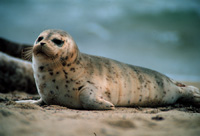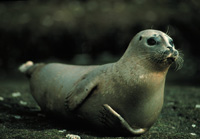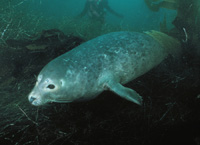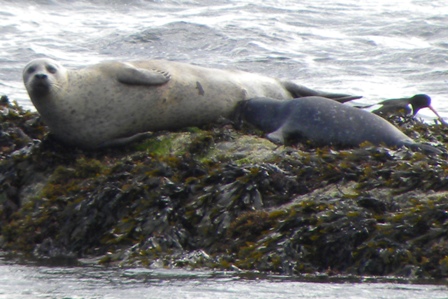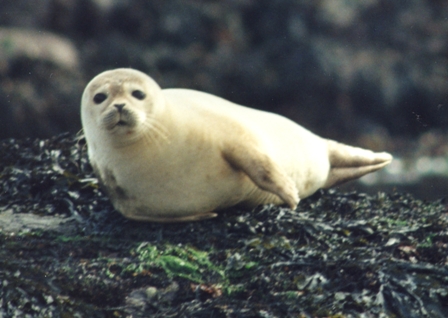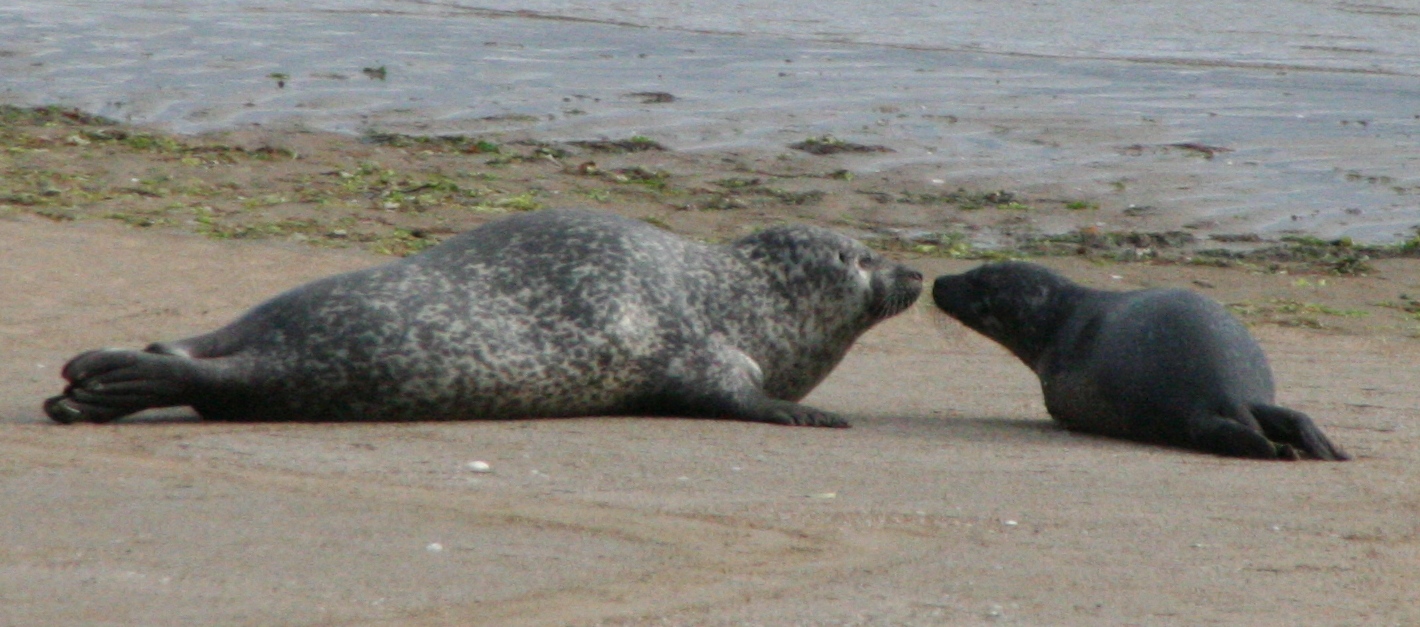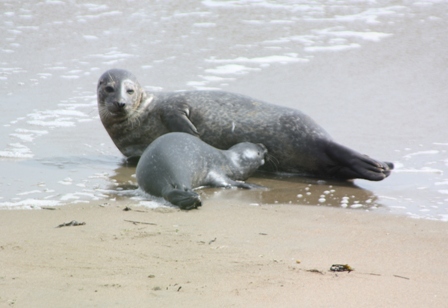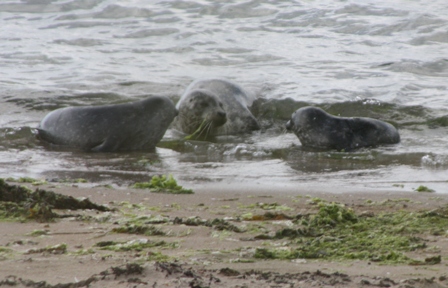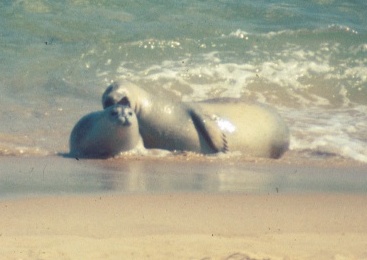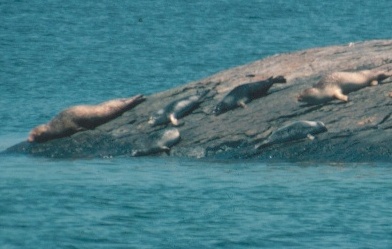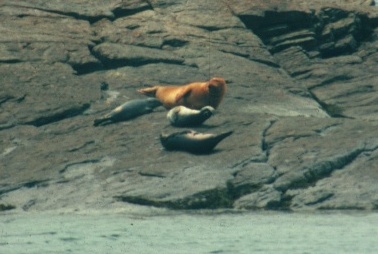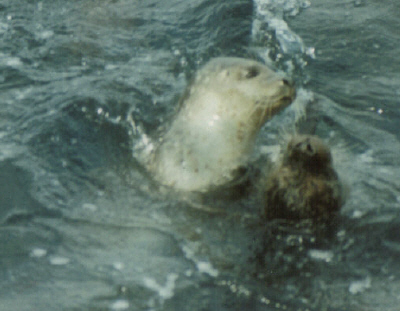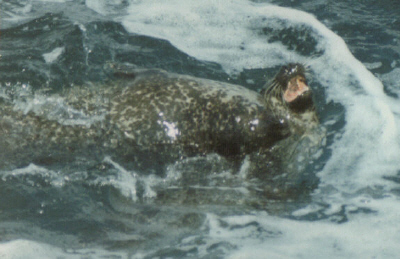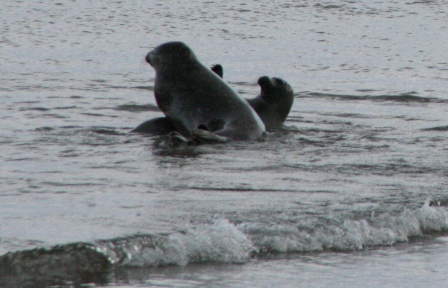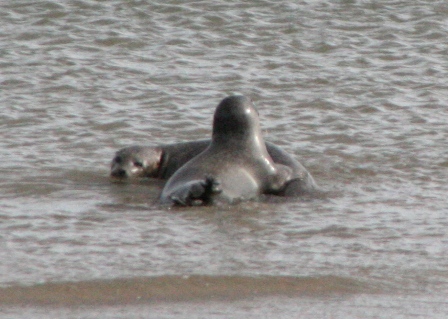This page is currently (September 2011) being updated, revised and references added
Harbour Seal
Phoca vitulina
IUCN STATUS (2010) - LEAST CONCERN
UNGAVA SEAL (P.v. mellonae) - ENDANGERED (COSEWIC, 2007)
| Distribution and Numbers The harbour seal is the most widely-distributed pinniped, inhabiting temperate and subarctic coastal areas on both sides of the north Atlantic and north Pacific Oceans. Five separate subspecies are generally recognised at the present time. The total worldwide abundance estimate for the species is 350–500,000 (Thompson and Härkönen, 2008). |
| The eastern Atlantic harbour seal (P.v. vitulina), also known as the common seal, was estimated in 2008 to have a population size of about 83,200, including 27,150 in the UK and Ireland, 15,500 in the Wadden Sea, 13,000 in the Lijmfjorden and Kattegat/Skaggerak, 600 in the Baltic, 3,800 in Norway, 19,000 in Iceland and 700 in the Barents Sea. (SMRU, 2009). There was a breeding population in the Faroes, which was apparently hunted to extinction by 1845, and has not re-established (Bloch et al., undated web report). The western Atlantic harbour seal (P.v. concolor) is found from the eastern Canadian Arctic and Greenland down to New Jersey, individuals occasionally wandering as far south as Florida. The estimated number in New England is thought to be about 91,000 (NOAA, 2011), with a further 10,000 along the Canadian eastern coast (COSEWIC, 2007). There is no stock estimate for the small Greenland population, but it may be in the order of a few hundred seals, with 14 of 23 known breeding sites still being used by seals in the early 1990s (Teilmann and Dietz, 1994). There was, until recently, an apparently isolated population of P.v. concolor on Sable Island, Nova Scotia (Boulva & McLaren, 1979). This population had an annual pup production of more than 600 pups until the late 1980s, but this had reduced to fewer than 10 by 2002 (Bowen et al, 2003). |  P.v.vitulina Photo: Salko de Wolf, Ecomare |
|
The Ungava seal (P.v. mellonae), also known as the Lacs des Loups Marins harbour seal, lives in a series of land-locked, inter-connected freshwater 'seal' lakes of the Ungava peninsula of northern Quebec, although it is thought that the distribution is now limited to only three lakes (DFO, 2009). The number of Ungava seals is unknown but is probably a few hundred at most (COSEWIC, 2007; DFO, 2009).The eastern Pacific harbour seal (P.v. richardii) population consists of ~235,000 seals, distributed from the Pribilof and Aleutian Islands in Alaska as far south as Baja California. The population in Alaska is estimated at ~180,000 (NOAA, 2011). The harbour seals at Tugidak Island in Alaska has been monitored intensively since the 1970s, and has shown a decline in seals ashore during the 1970s and 1980s, from more than 6,000 to fewer than 1,000, followed by a slight increase in the 1990s to ~1,500 by 2000. Pup production increased from ~150 to ~250 from 1994 to 2000 (Jemison & Kelly, 2001; Jemison et al, 2006). Total harbour seal numbers in Washington and Oregon are estimated at ~22,000, and in California at ~34,000 (NOAA, 2011). The abundance of the western Pacific harbour seal, or Kuril seal (P.v. stejnegeri) is thought to be about 3,000–3,500 in the Kuril Islands, a similar number in the Commander Islands, and about 350 in Hokkaido, northern Japan (Thompson & Härkönen, 2008), where numbers remain low due to by-catch in the salmon fishery and local shooting by fishermen (Wada et al., 1991). AppearanceHarbour seals have a rounded head and muzzle, with the adult bod shape resembling a larger version of juveniles. The pattern of harbour seal coats varies widely. The background colour is pale grey in a newly moulted anmal, shading to pale brown or tan as the next moult approaches, and appears spotted or speckled is covered with light or dark rings, spots and blotches. In P.v. vitulina the adults usually appear to be speckled when dry, while the juveniles up to about 3 years have a more homogeneous colour of pale beige when dry. Juveniles sometimes have dark rings around the eyes, giving the apearance of wearing spectacles when dry. The pattern of speckles or spots on a harbour seal's coat is unique to each seal and does not change from year to year, a potentially useful feature in the identification of individuals. A red to orange coloration, caused by the attachment of iron oxides to the external hair shaft, is also found in a number of seals, especially in San Francisco Bay (Allen et al, 1993) and in Walton in Essex. |
|
Legal Status The eastern Atlantic harbour seal is listed as an Appendix III species under the Bern Convention, and the subpopulations in the Baltic and Wadden Seas are listed as an Appendix II species under the Bonn Convention. The species is also listed as a protected species under Annex II and Annex V of the European Community's Habitats Directive, and several important sites for the harbour seal have been proposed in EC member countries as Special Areas of Conservation under the Directive. The harbour seal on both the east and western coasts of the US is protected under the Marine Mammal Protection Act (MMPA) 1972, as amended. The eastern and Arctic populations of the Western Atlantic harbour seal were added to Canada's Species at Risk list for 1999 with the the status Indeterminate. The harbour seal population in Mexico, about 1,000 to 3,000 individuals, is fully protected under the Ley General de Vida Silvestre NOM-059-ECOL-1994 which forbids the killing, collecting or possession of the species or any part or product obtained from the species. The Ungava Seal has been assigned the status Vulnerable by the Committee on the Status of Endangered Wildlife in Canada, which describes it as a "unique endemic subspecies of harbour seals with limited range and low numbers, making it vulnerable to human impact and natural catastrophic events". It is thought that a proposed hydroelectric development may have an adverse impact on a large portion of the population's range by reducing the water level of the Lac des Loups Marins. The population currently has minimum legal protection in Canada and none of its habitat is protected. However the Quebec government is considering whether or not to give legal protection to a portion of the habitat. There is some occasional hunting of the seals by the local native peoples for subsistence purposes. The Ungava seal is listed as Data deficient on the IUCN Red List. Conservation Status |
|
Threats Seal-fisheries interactionsMany of the fish species eaten by harbour seals are also commercially fished, the resulting interactions between the seals and commercial fisheries being a source of mortality. Harbour seals can become entangled and drown in fishing nets and gear, especially by gillnet fisheries (e.g. Bjørge et al., 2002) and salmon trap fisheries (Wada et al., 1991). In several countries, such as Canada, Norway and the United Kingdom, it is legal to shoot harbour seals to protect fisheries or fish farms. Conservation groups are attempting to promote the development and use of humane non-lethal seal deterrence methods, including effective anti-predator nets on fish farms and the movement from open sea cage fish farms to land-based closed loop systems (eg Wilson and Pereira, 2009). An unknown level of illegal killing of harbour seals, mainly by fishing interests, also takes place throughout the species' range. |
mother and pup
Juvenile P.v.vitulina |
Culls of harbour seals are regularly called for by those who believe that the seals are eating too much fish, despite evidence showing that the simplified view of "fewer seals equals more fish" is misguided given the complexity of the marine food web (Wilson, 2003). Those opposing such culls say that the seals are being made scapegoats, and that overfishing, habitat alteration and marine pollution are the causes of dramatic decreases in fish stocks. Many seal populations are only just now recovering from bounty schemes and organised culling, most of which ended in the 1960s and 1970s (Wilson 2003).
|
HuntingHunting of harbour seals still takes place in Iceland, Norway and Greenland. The population in Greenland has disappeared in recent years from some of its former sites, and its numbers declining even in several protected areas. The harbour seal is prized by locals in Greenland for its meat and its fine silky hair, the harbour seal skin being part of the Greenlandic national costume. It is thought that about 40 seals are hunted in Greenland each year, but this figure may be understated. The kill of harbour seals by Alaskan native subsistence hunting in 1996 was estimated at 2,741 and is fairly constant from year to year. Several Northwest Indian tribes have developed or are developing regulations for the ceremonial and subsistence killing of harbour seals, one tribe having reportedly made plans for a commercial hunt of the species. Inuit natives also kill small numbers of seals in Canada.Environmental contaminantsThere has been considerable concern as to the effects on harbour seals of environmental contaminants such as organochlorines. PCBs and DDTs were believed to be implicated in the near extinction of the harbour seals in the Baltic and the Dutch Wadden Sea (Helander and Bignert, 1992; Reijnders, 1985) and in reproductive failure and death of newborn pups in the estuary of the industrial River Tees in NE England (Wilson, 2001). A landmark experiment demonstrated that captive harbour seals fed fish from the polluted Dutch Wadden Sea suffered reproductve impairment, while seals fed fish from the north-east Atlantic reproduced normally (Reijnders, 1986). There was also a concern that the effects of the 1988 epizootic affecting the eastern Atlantic harbour seal may have been worsened by impairment of the harbour seals' immune systems by pollutants (Hall et al., 1992) and a series of experiments with feeding captive harbour seals on polluted and non-polluted herring demonstrated the levels of pollution in the fish that could cause immune impairment (de Swart et al, 1994). The risk to harbour seals from oil and hydrocarbon contamination may be locally significant. In 1989 the oil spill from the tanker Exxon Valdez in Prince William Sound, Alaska, affected some of the largest harbour seal haulout sites in the area. It is thought that about a third of the harbour seals using oiled haulout sites were killed, and that pup production and survival were also affected. Not only did the seals become coated with oil and inhale volatile substances, but the oil was also incorporated in seal tissues, abnormal behaviour was experienced, and pathological brain damage occurred.Physical debris is an additional threat to harbour seals, individuals being killed throughout the species' range by entanglement in marine debris, particularly non-biodegradable fishing nets and plastic wrapping bands. |
Infectious diseaseIn the spring and summer of 1988 an epidemic of phocine distemper virus (PDV), a morbillivirus closely related to canine distemper virus (CDV), swept through harbour seal populations in the east Atlantic, killing over 18,000 eastern Atlantic harbour seals (Osterhaus and Vedder, 1988). 5378 seals were found dead in the Kattegat-Skagerrak of a total population of about 9100, i.e. a 60% mortality (Härkönen and Heide-Jørgensen, 1990). This dramatic epizootic became one of the best-studied of wildlife disease outbreaks. A second wave of this same virus again killed thousands of seals in 2002 (Jensen et al., 2002). In both cases the epidemic began at the Danish island of Anholt in the Kattegat, and subsequently spread to adjacent colonies in a step-wise manner infecting seals along the North Sea coasts, with the exception of seals in Norway and the Baltic. The origin of the epidemic may have been a mass migration of harp seals south to western Europe following the collapse of their diet staple capelin in the Barents Sea. Infection with PDV has been shown to be widepsread in harp seals from the Baents Sea and West ice (Markussen and Have, 1992). Harp seals were not seen at Anholt, but were seen at other harbour seal haul-outs in the North Sea. It is thought that grey seals may have been responsble for causing the virus to 'jump' to colonies, eg to the Irish Sea and the west of Ireland, remote from the epidemic source. Grey seals may carry the virus without showing symptoms, and form mixed haul-outs with harbour seals at many sites, including Anholt (Härkönen et al., 2006). At least 445 harbour seals, mostly juveniles, died of acute pneumonia due to an Influenza A virus of avian origin that lasted 22 months in New England from 1979-80 (Webster et al., 1981) Geraci et al (1982) suggested that a mycoplasma combined with the virus and also high densities of seals hauled out during unseasonably warm temperatures may have contributed to the spread of the virus. In 1997 about 90 dead harbour seals stranded on the Californian coast, and a smaller mortality recurred in 2000. The cause appeared to be a virus of some type (NOAA). An unidentified pathogen probably a virus, appeared to be the cause of the death of about 80 harbour seals on Anholt and a further 100 along the Swedish North Sea coast in the summer of 1997 (Härkönen et al., 2007). It was initially feared that this infection would spread further, but fortunately it did not do so.
|
| Disturbance by human recreational activities has been highlighted by a long-running controversy at a haul-out site at La Jolla in southern California. Here there is a breeding colony of seals using a beach - which is also designated as a children's pool - for haul-out and nursing pups. A reserve was established in 1994 to protect the seals from harassment and disturbance, but this protection seems not to be strongly enforced. |
|
|
|
P.v.vitulina mother-pup pairs - left to right: nose-to-nose contact, suckling at water's edge, pup following in water, lone pup approaches mother-pup pair
|
Pupping and pup developmentHarbour seal pups are usually born close to the water's edge. Most pups are born with their adult coat, having shed a grey-white woolly coat before birth. Pups of some subspecies, however, are born with this pre-natal coat and moult it shortly afterwards. 16% of P.v. concolor pups on Sable Island are born with the lanugo coat (Boulva, 1971). Most harbour seal pups are born in the intertidal area, on rocky ledges or beaches subject to daily tidal flooding. |
| Births normally occur within 3.5 minutes of visible contractions, although if females are disturbed in labour, they are able to cease contractions or even re-enter the water for a least several minutes (Lawson and Renouf, 1985). For the first 30 to 60 minutes after birth the mother will nose the the pup's head and neck and initiate repeated nose-to-nose contacts with it. This post-natal mutual nosing period is believed to be critical to formation of the mother-pup bond (Lawson and Renouf, 1985; Wilson, pers. obs.). |
| Immediately after birth the pup may be extremely active, being able to move about onshore and swim for short periods. swim rapidly around, making 'frolicking' movements in the water. Possibly this activity provides the pup with vestibular and other stimulation (see later discussion of play) which 'kick-starts' the coordination of sensory stimulation and locomotor movement necessary for following its mother through the water. Some pups are even born directly into the water while the mother is still on the rock, and will make strenuous efforts to reach the mother and interact with her (Wilson, pers. obs). This adaptation is essential for those pups born in intertidal areas, since they often have no alternative to entering the water within a short time - usually about an hour - of birth (Wilson, pers. obs.). |
| The harbour seal mother looks after her pup for about 3–4 weeks, with some individual variation in length of the lactation period. The behaviour of mother and pup was first described in Shetland by Venables and Venables (1955). The mother chaperones the pup closely, leads it in and out of the water, and stays with the pup in the water if it does not immediately succeed in hauling out after her. Very young pups sometimes ride on their mother's back. The pup has a hghly developed following response, and makes strenuous efforts to follow its mother closely, both on land and in the water (Wilson, 1974; Renouf et al., 1983; Lawson and Renouf, 1987). While the mother is leading the pup, she swims at the pup's pace, frequently pausing and leaning back to make nose-to-nose contact with it. The pup appears to orientate towards the mother's neck, and it appears that the neck region of harbour seals has highly developed sebaceous glands, which presumably emit an odour which in involved in social attraction and bonding. Nose contact with the head and neck area occurs frequently during play of mother and pup, which is thought to reinforce the social bond (Wilson and Kleiman, 1974). Pups have a distinctive distress call, which sounds a little like that of the calf of the domestic cow (hence the french name for this species 'veau marin'). The voices of individual pups differ in fundamental frequency and to some extent in harmonic pattern. When mother and pup are in the water, when the mother's head is only partly surfaced, she may hear both the aerial and underwater version of her pup's call (Renouf, 1984), and adult females are able to distinguish between the calls of different pups (Renouf, 1985). |
|
| Harbour seal mothers fast during the first week and a half of lactation. From mid-lactation they start to feed in order to maintain their milk supply, making foraging trips with bouts of diving to find prey (Boness et al., 1994). Pups may sometimes dive with their mothers, but their dives are shorter and much shallower. Pups, both in Norway and Sable Island, fitted with tracking devices have been found to descend with their mother at the beginning of a dive, but return to the surface separately and then dive again, presumably to rejoin their mother (Bowen et al, 1999; Bekkby, 1999). Between the ages of 2d and 19 days most pup dives a Svalbard were 4-6m and lasted 10–20, although pups were found to increase both the depth and the number of U-shaped dives (where they spend part of the dive time at the sea bed as they would when foraging) as they got older (Jørgensen et al, 2001). |
| Pups only sometimes accompany their mothers on dives, however. Wilson (1974) found that mothers at a site in Ireland dived close to the haul-out site, leaving the pup sleeping at the surface and returning to check the up between dives. However, more recently at other sites in Ireland, mothers are regularly seen to 'park' their pups at the haul-out site and go off (presumably to forage) without them, and later return to claim them. These 'lone pups' tend to stay with the group, often amongst other pups, and follow the group of seals if they move from rock to rock as the tide fluctuates (Wilson, pers. obs.). Pups on Sable island were also often left on the beach while their mothers were away foraging (Bowen et al, 1999). These different observations are doubtless due to differences in the foraging ecology of the area, and a sizeable group of seals in which to leave the pup and where the mother may easily find it with the haul-out group again on her return. |
|
P.v.concolor, Sable Island. Mother play-bites pup's neck |
Despite their diving prowess, pups do not apparently actively forage for small prey until after they have stopped suckling and are completely weaned. Their first prey has been found to be small sandeels and gadoid fish of up to about 8cm long at Sable Island (Muelbert and Bowen, 1993) and, similarly in a colony in Ireland, small gadoid fish of average length 8 cm (Wilson et al., 2002). Most pups began feeding, on average 10 days post-weaning, although some pups (about 20%) fasted for about 3 weeks (Muelbert and Bowen, 1993). During the first month postweaning, pups at Sable Island lost an average 4 kg from an initial average of 24 kg at weaning, and apparently took about 4–6 weeks to achieve a positive energy balance (Muelbert et al., 2003). |
|
P.v.concolor, Maine. Clusters of weaned pups: 4 pups (left), 2 pups haul out together on small ledge (centre), 3 pups haul out together and approach adult male (right). |
| Immediately after weaning at about 3.5 weeks of age, the pups remain close to the nursery site for the next 2–3 weeks. They haul out together to rest in small clusters and may follow one another in the water. During this time they apparently learn to catch very small fish in the shallow water around the nursery site. A study of a P. v. concolor colony in Maine (Wilson, 1978) described the development of social responsiveness of pups to one another, including nose-to-body contacts and playful behaviour. Pup group size increased to 9–11 pups swimming and apparently foraging together in a manner that has has not been documented elsewhere. |
| In a P. v. vitulina colony in Ireland, pups between ~5–8 weeks of age began to disperse to offshore areas - apparently individual foraging sites - up to ~50km from their nursery site. Between 2 and 4 months of age they rarely returned to the haul-out site, remaining at sea in these coastal foraging areas (Wilson et al., 2007). The patterns of pup foraging and dispersal doubtless depend heavily on the local distribution and density of small prey species. |
| It is very important for weaned pups to learn to feed effectively during late summer and early autumn. A study of P. v. vitulina pups in the Skagerrak found that the survival of pups during the winter was strongly correlated with their weight in the autumn (at ages between 10 and 27 weeks), with pups weighing 32kg in the autumn having a 0.96 probability of survival to one year of age compared with the probability for the smallest pups weighing 17kg of only 0.63 (Harding et al., 2005). |
| The pup's movements after weaning are varied. The distance travelled from the natal site depends on the distribution and abundance of prey. However, young harbour seals generally show site fidelity. Some young pups studied in Alaska made journeys of more than 75km to foraging sites, while others traveled less than 25km. However, the pups mostly returned to their natal site by the following spring (Small, 2005). Similarly, 40-50% of pups in the Skagerrak returned to their natal site for their first moult as yearlings, and 70% returned by the age of 2 years; none of their study animals travelled more than 32km over a 14 year period (Härkönen and Hårding, 2001). |
The annual moultThe harbour seal moult - for all seals older than pups - follows the pupping season. The moulting season usually lasts about 4–5 weeks, although the time of the moult for individuals may vary according to age, sex and reproductive status (Thompson and Rothery, 1987). During the moult the seals' skin heats up to aid the in the shedding and regrowth of their hair. They therefore spend as much time as possible hauled out during the moult in order to conserve heat and avoid excess energy loss. It is therefore important not to disturb moulting seals, as this may cause them to waste valuable energy as they escape into the water. |
MatingMating of harbour seals was first described at a readily visible colony of P. v. vitulina in Shetland (Venables and Venables, 1957). They observed sexual pairing taking place in September, between seals who had already completed their moult. From the beginning of September, as seals were completing their moult, seals became very active, leaping ('porpoising') and 'rifle shot' splashing at the surface, Actual coitus, seen on several occasions, was preceded by the pair 'rolling' over one another, and splashing. The pair then coiled downwards towards the sea bed, each seal blowing a fountain of bubbles. They either floated up again in the tail of the bubble stream and the interaction waned, or the male mounted the female, clasping her in the axillary region,and sometimes mouthing the back of her head. This usually happened underwater, close to the sea bed. Despite these observations, it is considered that the timing of harbour seal mating of P. v. vitulina in September probably does not apply to all populations. Thompson (1988) observed neck scarring in adult males, apparently caused by bites, peaking in July and declining through August to a low in September. He assumed that the neck wounds were due to fighting between males, which apparently occurred in the water offshore. He also assumed the fighting probably coincided with the mating period, which would then have been timed to coincide with the end of lactation in late July and early August. This would be compatible wth the post-lactation mating season in most other phocids. Observations by Allen (1985) of coitus in P.v. richardii in late May and early June, i.e. post-lactation and before the moult, support the theory that this may be the more common pattern and the Shetland pattern less usual. Adult males of P.v. richardii and P.v. concolor have been shown to produce an underwater 'roar', whch has different characteristics for different individuals (Hanggi and Schusterman, 1994). It is thought that males of P.v. richardii - hold underwater territories for mating, and that the 'roar' is a challenge from an intruding male, whch will produce an aggressive response (Hayes et al., 2004). Similar behaviour has ben described for P.v. vitulina males in Norway, where males were found to be calling in the deeper channels between haul-out sites used by mothers and pups (Bjørge et al., 1995). The most successful territories for P.v. richardii were held either offshore along the open coast or along the travel corridor to and from the haul-out site Genetic studies, however, have shown that most males father no more than one pup in a season (Hayes et al., 2006). P.v. vitulina males in the Moray Firth in Scotland began to restrict their range of movements at the time of mid–late lactation, and engaged in diving and acoustic displays. Males differed in the display areas that they used, some staying close inshore and others moving further offshore (Van Parijs et al., 1997). |
|
P.v. vitulina, Shetland. Two juveniles play 'rolling' in shallow water beside haul-out site |
P.v. vitulina, Ireland. An adult and a juvenile play at water's edge at haul-out site |
Social behaviourHarbour seals have rich social lives, manifest by play behaviour close to the haul-out site (Wilson, 1974; Wilson and Kleiman, 1974). In the water, seals may play in pairs, 'rolling' by twisting and somersaulting over each other in continuous contact. This resembles pre-coital behaviour described by Venables & Venables (1957), but there is no mounting or detectable sexual element. The tempo of rolling may be fast, with much splashing, and may grade into slower movement, where the seals may hold one another with eyes closed. Rolling occurs in all age groups, including mother-pup, weaned pups, juveniles and adults. Play may also occur at the water's edge in just a few cm of water. Here the head-over-body play signal predominates, and play fighting may occasionally occur. This play behaviour is thought to enhance the social bond between individuals. Another type of play, called 'group play' may also occur as seals haul out. This involves less body contact, but much 'porpoising', 'streaking' (swimming rapidly at the surface, creating much foam), splashing and leaping on and off the rock as another seal approaches. Adults as well as juveniles may engage in play (Wilson, 1974; Renouf and Lawson, 1986). Group play probably enhances the bonding between group members, and the 'boisterous exaggeration' of play locomotor movement may produce vestibular stimulation (Renouf and Lawson, 1986). |
The haul-out groupThe functions of the harbour seal haul-out group may be various. A group of seals resting on a haul-out maintains a more effective vigilance than seals hauled out alone. Another function may be as an 'information centre' When seals return to the water, they may follow their neighbour to a successful foraging area. Whatever its functions, it is likely - given the site fidelity of animals over many years, and the relatively small group size - that individual seals in a group 'know' each other and there may be social bonding to a greater or lesser extent between different individuals of different ages or sexes within a group. Some haul-out groups in some populations are dominated by one age or sex class. Some groups comprise mainly mothers and pups, some mainly adult males and some mainly juveniles (Wilson, 1974a,b; Wilson & Kleiman, 1974; Thompson, 1989; Kovacs, Jonas and Welke, 1990). Within mixed age/sex haul-out groups of P.v. richardii, seals may be segregated by age and sex, and this may be most pronounced during te pupping period, when new mothers tend to be intolerant of the proximity of males and juveniles (Allen et al., 1988). Social cohesion is not readily visible when animals are studied only while they are hauled out and resting (Davis and Renouf, 1987), and - especially in large colonies such as that formerly on Sable Island - stable social units were not evident from the structure of haul-out groups (Godsell, 1988). The reason for this is that most cohesive social interaction between harbour seals occurs either in the water or within the splash zone at the water's edge - once the seal haul out to rest, their position relative to other seals on the beach often seems to be relatively unimportant. |
| Once they are dry and settled on the haul-out site, harbour seals display only a very low level of interaction. They generally maintain an inter-individual space of at least 0.5m, and if a newly hauling seal comes too close, flippering or mild sparring may ensue. This may be more apparent when haul-out space is limited and more in some populations more than others (Wilson, 1978; Sullivan, 1982; Godsell, 1988), but - at least in P.v. vitulina - the resting haul-out group is generally very peaceful. |
Foraging and dietHarbour seals are opportunistic foragers, feeding in coastal shallow waters on locally and seasonally abundant prey, mostly fish, but also shrimps and small cephalopod molluscs. The seals forage mainly close to the seabed, mainly on small groundfish including gadoid fish (such as whiting, pollock, poorcod) flatfish (such as plaice and flounder), sandeels, herring and sprat. They usually select small fish which can be swallowed whole. A 'crittercam' fitted to the back of seals at Sable island revealed foraging tactics of adult males (Bowen et al., 2002). The seals foraged for sandeels by cruising at medium speed 1–2m from the seabed, and caught fish by thrusting their heads towards the bottom nas sandeels appeared, or routing in the sand for several seconds. They also occasionally dug in the sand using their foreflippers. They used similar tactics for foraging for flounders. They sometimes regurgitate underwater and then eat the regurgitated fish again - possibly to eliminate some sand and seawater. They also foraged on sandeel schools by breaking the school into smaller units, or separating individuals at the edge of the school and then pursuing isolated individuals. The foraging tactics can be broadly classified into 'sit-and-wait' ('ambush') and active searching, and varied acording to the visibility, speed and behaviour of the prey. The smallest prey were the least profitable to pursue in terms of energy, which emphasises the struggle experienced by young pups in achieving a positive energy balance during their first 6 weeks post-weaning, since they evidently 'learn' their first foraging skills on the smallest prey. |
| Harbour seals are opportunistic predators, able to switch prey according to annual and seasonal variability (e.g. Härkönen, 1987b; Payne and Selzer, 1989; Hall et al., 1998; Brown et al., 2001). The diet of the harbour seals in the Moray Firth in Scotland is dominated by clupeids (herring and sprat) when these are available. However when they have to switch from clupeids to the locally abundant gadoid fish, there was evidence of widespread macrocytic anaemia. Gadoid fish have a lower calorific content than clupeids or sandeels, but the reason for the anaemia is because the gadoid fish apparently contain an antimetabolite which reduces iron absorption (Thompson et al., 1997). This finding has serious implications for the health of harbour seal populations in areas where the seals' energy-rich prey such as herring and sandeels have been commercially over-fished, and they are having to substitute gadoid fish as their diet staple (e.g. Wilson et al., 2002). |
|
Harbour seals are often accused of affecting stocks of valuable commercial fish, such as salmon and cod, and have frequently been shot by fishermen for this reason. The numerous studies of harbour seal diet in many parts of their range (of whch a few are cited here) have generally found salmonids to be a non-existent or negligable part of the diet (Pierce et al., 1997). However, there are exceptions, and salmon are occasionally a small and seasonal part of the diet of harbour seals living in the vicinity of salmon rivers, though rarely away from nets (Pierce et al., 1991). Salmon comprised a total of 4% of the diet by weight of a colony of P.v. richardsii in British Columbia (Olesiuk, 1993) and 9% in a colony of P.v.vitulina in a Loch on the west of Scotland (Boyle, 1990). However, studies of the foraging behaviour of harbour seals in the Moray Firth in Scotland showed that they targeted shoals of sprat and small herring duing the day when they were densely packed near the seabed (Thompson et al. 1991). Adult and juvenile salmonids may therefore only be attractive to seals when moving in relatively large concentrations along the coast and when confined in river estuaries. Even when hauled out near salmon river estuaries, harbour seals have been found to feed routinely on non-salmonid sea fish (Pierce at al., 1997). The collapse of the cod fishery in the Skagerrak and Kattegat in the latter half of the 20th century, and this coincided with an increase in the harbour seal population, due to a reduction in human persecution. This led to renewed calls for seal culling. However, analysis of the magnitude of cod-seal interaction concluded that harbour seals have a negligable effect on the commercial cod fishery (Hansen and Harding, 2006). Statistics |
|
Pupping seasons vary for different populations, with mean birth dates ranging from 15 March to Sept 3 (Temte et al., 1991). The range for the east Atlantic P. v. vitulina estimated by these authors was June 16 to July 17; for the west Atlantic P. v. concolor, including Greenland, the mean dates were earlier, from May 02 to July 10. The Ungava seal pupping dates are mid-April to mid-May. For the east Pacific P. v richardsi the dates varied according to latitude, between March 25 and May 07 between Mexico to Washington State, between July 25 and August 13 in British Columbia and from BC to Alaska between June 17 and July 08. Mean pupping for P.v. stejnegeri takes place between May 25 and June 05 (Temte et al., 1991). A gradually earlier pupping season for P.v.vitulina in the Wadden Sea has been documented since the early 1970s, with the birth date shifting on average by 0.71 days/year between 1974 and 2009. It was deduced that probably the embryonic diapause (period of delayed implantation after mating and fertilistion) has been shortened, possibly because of more small fish available to females during the post-mating period, this being possibly due to overfishing of adult and larger predatory fish (Reijnders et al., 2010). |
| Internet links
Watch a Sable Island harbour seal fitted with a 'crittercam' foraging on sandeels La Jolla Friends of the Seals video explaining the origins of the seals and the controversy Video explaining the controversy at La Jolla Video of harbour seal colony at La Jolla beach (undisturbed) Video of small harbour seal colony on a beach at Fitzgerald Marine Reserve. Note the greater social activity of seals at the water's edge Video of harbour seal birth at La Jolla (1). The pup is born at the water's edge. The video shows nosing contacts by the mother just after birth, the pup's high activity level and ability to swim immediately after birth, the mother's chaperoning behaviour, and the hovering of a gull anticipating the afterbirth. Judging by the soundtrack, the human audience may have been rather too close and too loud in its cheering at the moment of birth. Video of a harbour seal birth at La Jolla (2). This time the pup was born on a dry part of the beach. The amniotic sac is clearly seen. Again, a gull is waitng for the afterbirth. Video of older harbour seal pup activity at water's edge (probably also at La Jolla). |
References
Allen, S.G. (1985). Mating behaviour in the harbour seal. Mar. Mamm. Sci. 1: 84–87.
Allen, S.G., Ribic, C.A. and Kjelmyr, J.E. (1988). Herd segregation in harbor seals at Point Reyes, California. Calif. Fish and Game 74(1): 55–59.
Alen, S.G., Stephenson, M, Risebrough, R.W., Fancher, L., Shiller, A. and Smith, D. (1993). Red-pelaged seals of the San Francisco bay region. J. Mamm. 4(3): 588–593.
Bekkby, T. and Bjørge A. (2000). Diving behaviour of harbour seal Phoca vitulina pups from nursing to idependent feeding. J. Sea Res. 44: 267-275.
Bloch, D. , Mikkelsen, B. & Ofstad, L.H. undated. Marine Mammals in Faroese waters. http://www.foib.fo/foibportal/projects/eia/Faroe_eia/Studies/Mammal_Final_Part1.pdf
Bjørge, A., Thompson, D., Hammond, P., Fedak, M., Byant, E., Aarefjord, H., Roen, R. and Olsen, M. (1995). Habitat use and diving behaviour of harbour seals in a coastal archipelago in Norway. In Whales, seals, fsh and man, eds. Blix, A.S., Walløe and Ø. Ulltang. Elsevier Science. Pp. 211–223.
Bjørge, A., Øien, N., Hartvedt, S. and Bekkby, T. (2002). Dispersal and by-catch mortality in gray, Halichoerus grypus, and harbor, Phoca vitulina seals tagged at the Norwegian coast. Mar. Mamm. Sci. 18(4): 963–976.
Boness, D.J., Bowen, W.D. and Oftedal, O.T. (1994). Evidence of a maternal foraging cycle resembling that of otariid sals in a small phocid, the harbor seal. Behav. Ecol. Sociobiol. 34: 95–104.
Boulva, J. (1971). Observations on a colony of whelping harbour seals, Phoca vitulina concolor, on Sable Island, Nova Scotia. J. Fish. Res. Bd. Canada 28: 755–759.
Boulva, J. & McLaren, I.A. (1979). Biology of the harbor seal, Phoca vitulina, in Eastern Canada. Bull. Fish. Res. Bd. Canada Bull. 200: 24pp.
Bowen, W.D., Tully, D., Boness, D.J., Bulheier, B.M. and Marshall, G.J. 2002. Prey-dependent foraging tactics and prey profitability in a marine mammal. Mar. Ecol. Prog. Ser. 244: 235–245.
Bowen, W. D., Ellis, S. L., Iverson, S. J. and Boness, D. J. (2003). Maternal and newborn life-history traits during periods of contrasting population trends: implications for explaining the decline of harbour seals (Phoca vitulina), on Sable Island. Journal of Zoology (London) 261: 155-163.
Bowen, W.D., Boness, D.J. and Iverson, S.J. (1999). Diving behaviour of lactating harbour seals and their pups during maternal foraging trips. Can. J. Zool. 77: 978–988.
Brown, E.G., Pierce, G.J., Hislop, J.R.G. and Santos, M.B. (2001). Interannual variation in the summer diets of harbour seals Phoca vitulina in Mousa, Shetland. J. Mar. Biol. Ass. U.K. 81: 325–337.
Boyle, G.J. (1990). The feeding ecology of common seals (Phoca vitulina L.) in Loch Linnhe, West Scotland. MSc thesis, Imperial College, Univ. Lond.
Calambodikis, J., Steiger, G.H. and Healey, L.E. 1983. Behavior of harbor seals and their reaction to vessels in Glacier bay, Alaska. Presentation to the 5th Biennial Conference on the Biology of Marine Mammals. Nov 27–Dec 01, 1983.
Coltman, D.W., Bowen, W.D. and Wright, J.M. (1998). Birth weight and neonatal survival of harbour seal pups are positively correlated with genetic variation measured by microsatellites. Proc. R. Soc. Lond. B 265: 803–809).
COSEWIC. (2007). Assessment and update status report on the harbor seal (Phoca vitulina)- Atlantic and eastern Arctic subspecies (P.v. concolor) and Lacs des Loups Marins subspecies (Phoca vitulina mellonae). http://dsp-psd.pwgsc.gc.ca/collection_2008/ec/CW69-14-78-2008E.pdf
Cottrell, P.E., Jeffries, S., Beck, B. and Ross, P.S. (2002). Growth and development in free-ranging harbor seal (Phoca vitulina) pups from southern British Columbia, Canada. Mar. Mamm. Sci. 18(3): 721–733.
Cowan, D.F., House C. and House, J.A. (undated). Public Health. In CRC handbook of marine mammal medicine. Eds. Dierauf, L.A. and Gulland, F.M.D. Ch 34, pp. 767–778. CRC Press, London & NY.
Da Silva, J. and Terhune, J.M. (1988). Harbour seal grouping as an anti-predator strategy. Anim. Behav. 36: 1309–1316.
Davis, M.B. and Renouf, D. (1987). Social behaviour of harbour seals, Phoca vitulina, on haul-out grounds at Miquelon. Canadian Field Naturalist 101(1): 1–5.
De Swart, R.L., Ross, P.R., Vedder, L.J., Timmerman, H.H., Heisterkamp, S., Loveren, H.V., Vos, J.G., Reijnders, P.J.H. and Osterhaus, A.D.M.E. (1994). Impairment of immune function in harbor seals (Phoca vitulina) feeding on fish from polluted waters. Ambio 23: 155–159.
DFO. (2009). Recovery assessment for freshwater harbour seal Phoca vitulina mellonae (Lac des Loups Marins Designated Unit (DU)). DFO Can. Sci. Advis. Sec. Sci. Advis. Rep. 2008/062. http://www.dfo-mpo.gc.ca/CSAS/Csas/Publications/SAR-AS/2008/SAR-AS2008_062_e.pdf
Drescher, H.E. (1979). Biologie, Ökologie und Schutz der Seehunde im Schleswig-holsteinischen Wattenmeer. PhD Thesis, Institut für Haustierkunde (p.36–37), Univ Kiel. Meldorf, 1979.
Geraci, J.R., St. Aubin, D.J., Barker, I.K., Webster, R.G.,Hinshaw, V.S., Bean, W.J., Ruhnke, H.L., Prescott, J.H., Early, G., Baker, A.S., Madoff, S. and Schooley, R.T. (1982). Mass mortality of harbor seals: pneumonia assciated with influenza A virus. Science 215: 1129–1131.
Godsell, J. (1988). Herd formation and haul-out behaviour in harbour seals (Phoca vitulina). J. Zool. Lond. 215: 83–98.
Hall, A.J., Law, R.J., Wells, D.E., Harwood, J., Ross, H.M., Kennedy, S., Allchin, C.R., Campbell, L.A. and Pomeroy, P.P. (1992). Organochlorine levels in common seals (Phoca vitulina) which were victims and survivors of the 1988 phocine distemper epizootic. Sci. Total. Environ. 115: 145–162.
Hall, A.J., Watkins, J. and Hamond, P.S. (1998). Seasonal variation in the diet of harbour seals in the southwestern North Sea. Mar. Ecol. Prog. Ser. 170: 269–281.
Hanggi, E.B. and Schusterman, R.J. (1994). Underwater acoustic displays and individual variation in male harbour seals, Phoca vitulina. Anim. Behav. 48: 1275–1283.
Hansen, B.J.. and Hårding, K.C. (2006). On the potential of harbour seal predation on the cod population in the eastern North Sea. J. Sea Res. 56: 329–337.
Hårding, K.C., Fujiwara, M., Axberg, Y. and Härkönen, T. (2005). Mass-dependent energetics and survival in harbour seal pups. Functional Ecology 19: 129–135.
Härkönen, T.J. (1987a). Influence of feeding on haul-out patterns and sizes of sub-populations in harbour seals. Neth. J. Sea Res. 21(4): 331–339.
Härkönen, T.J. (1987b). Seasonal and regional variations in the feeding habits of the harbour seal, Phoca vitulina, in the Skagerrak and the Kattegat. J. Zool. Lond. 213: 535–543.
Härkönen, T. and Heide-Jørgensen, M.-P. (1990). Comparative life histories of East Atlantic and other harbour seal populations. Ophelia 32(3): 211–235.
Härkönen, T.J. and Hårding, K.C. (2001). Spatial structure of harbour seal populations and the implications thereof. Canadian Journal of Zoology 79:2115–2127.
Härkönen, T., Dietz, R., Reijnders, P., Teilman, J., Harding, K, Hall, A., Brasseur, S., Siebert, U., Goodman, S.J., Jepson, P.D., Rasmussen, T.D. and Thompson, P. (2006). A review of the 1988 and 2002 phocine distemper virus epidemics in European harbour seals. Dis. Aquat. Org. 68: 115–130.
Härkönen, T, Bäcklin, B.M., Barrett, T., Bergman, A., Corteyn, M, Dietz, R., Harding, K.C., Malmsten, J., Roos, A. and Teilmann, J. (2007). Mass mortality in harbour seals and
harbour porpoises caused by an unknown pathogen. Veterinary Record:162, 555-556.
Hayes, S.A., Kumar, A., Costa, D.P., Mellinger, D.K., Harvey, J.T., Brandon L., Southall, B.L. and Le Boeuf, B.J.(2004). Evaluating the function of the male harbour seal, Phoca vitulina, roar through playback experiments. Anim. Behav. 67(6): 1133-1139. doi:10.1016/j.anbehav.2003.06.019.
Hayes,S.A., Pearse, D.E., Costa, D.P., Harvey, J.T., LeBoeuf, B.J. and Garza, J.C. (2006). Mating system and reproductive success in eastern Pacific harbour seals
DOI: 10.1111/j.1365-294X.2006.02984.x
Helander, B. and Bignert, A. (1992). Harbor seal (phoca vitulina) on the Swedish Baltic coast: population trends and reproduction. Ambio 21(8): 504–510.
Jansen, J.K., Boveng, P.L., Dahle, S.P. and Bengtson, J.L. (2010). Reaction of harbor seals to cruise ships. J Wildife Manag. 74(6): 1186–1194.
Jensen, T., van de Bildt, M., Dietz, H.H., Anderson, T.H., Hammer, A.S.,, Kuiken, T. and Osterhaus, A.D.M.E. (2002). Another phocine distemper outbreak in Europe. Science 297: 209.
Jørgensen, C., Lydersen, C., Brix, O. and Kovacs, K.M. (2001). Diving development in nursing harbour seal pups. J. Exp. Biol. 204: 3933-4004.
King, J.E. (1983). Seals of the World (2nd ed.) British Museum, Cornell Univ. Press, Ithaca, NY. 240pp.
Kovacs, K.M., Jonas, K.M. and Welke, S.E. (1990). Sex and age segregation by Phoca vitulina concolor at haul-out sites during the breeding season inthe Passamaquoddy Bay region, New Brunswick. Mar. Mamm. Sci. 6(3): 204–214.
Lawson, J.W. and Renouf, D. (1985). Parturition in the Atlantic harbor seal Phoca vitulina concolor. J. Mamm. 66(2): 395–398.
Lonergan, M., Duck, C.D., Thmpson, D., Mackey, B.L., Cunningham, L& Boyd, I.L. (2007). Using sparse survey data to investigate the declining abundance of British harbour seals. J. Zool. 271: 261–269.
Markussen, N.H., Bjørge, A. and Øritsland, N.A. (1989). Growth in harbour seals (Phoca vitulina) on the Norwegian coast. J. Zool. Lond. 219: 433–440.
Markussen, N.H. and Have, P. (1992). Phocine distemper virus infection in harp seals (Phoca groenlandica). Mar. Mamm. Sci. 8(1): 19–26.
Muelbert, M.M.C., Bowen, W.D. and Iverson, S.J. (2003). Weaning mass affects changes in body composition and food intake in harbour seal pups during the first month of independence. Physiol. Biochem. Zool. 76(3): 418–427).
NOAA (2011). http://www.nmfs.noaa.gov/pr/species/mammals/pinnipeds/harborseal.htm
Osterhaus, A.D.M.E. and Vedder, E.J. (1988). Identification of virus causing recent deaths. Nature 335: 20.
Osterhaus, A.D.M.E., Rimmelzwaan, G.F., Martina, B.E.E., Bestebroer, T.M. and Fouchier, R.A.M. (2000). Influenza B virus in seals. Science 288: 1051–1053.
Pauli, B.D. and Terhune, J.M. (1987). Tidal and temporal interaction on harbour seal haul-out patterns. Aq. mamm. 13(3): 93–95.
Payne, P.M. and Selzer, L.A. (1989). The distribution, abundance and selected prey of the harbor seal, Phoca vitulina concolor, in southern New England. Mar. Mamm. Sci. 5(2): 173–192.
Pierce, G.J., Hislop, J.R.G. and Carter, T.J. (1997). Interaction between seals and salmon in northeast Scotland. The Salmon Net, XXVIII: 49–55.
Quick, N.J., Middlemass, S.J. and Armtrong, J.D. 2002. The Use of anti-predator controls at Scottish marine salmon farms. Report for the Scottish Executive by Fisheries Research Services (an agency of the Scottish Executive).
Reijnders, P.J.H. (1985). On the extinction of the Southern Dutch harbour seal population. Biol. Conserv. 31: 75–84.
Reijnders, P. J. H. 1986. Reproductive failure in common seals feeding on fish from polluted coastal waters. Nature 324: 456-457.
Reijnders, P.J.H., Brasseur, S.M.J.M. and Meesters, E.H.W.G. (2010). Earlier pupping in harbour seals. Biol. Lett. doi: 10.1098/rsbl.2010.0468.
Renouf, D. (1984). The vocalization of the harbour seal pup (Phoca vitulina) and its role in the maintenance of contact with the mother. J. Zool. Lond. 202: 583–590.
Renouf, D. (1985). A demonstration of the ability of the harbour seal Phoca vitulina (L.) to discriminate among pup vocalizations. J. Exp. Mar. Biol. Ecol. 87: 41–46.
Renouf, D., Lawson, J and Gaborko, L. (1983). Attachment between harbour seal (Phoca vitulina) mothers and pups. J. Zool. Lond. 199: 179–187).
Renouf, D. and Lawson, J.W. (1986). Play in harbour seals (Phoca vitulina). J. Zool. Lond. (A) 208: 73–82.
Ross, A. 1988. Controlling nature’s predators on fish farms. Report for the Marine Conservation Society. x+96pp.
Schneider, D.C. and Payne, P.M. (1983). Factors affecting haul-out of harbor seals at a site in southeastern Massachusetts. J. Mamm. 64(3):518–520.
Small, R.J. (2005). Differential movements by harbor seal pups in contrasting Alaska environments. Mar. Mamm. Sci. 21(4): 671–694.
SMRU (2009). Scientific advice on matters related to the management of seal populations: 2009. http://www.smru.st-andrews.ac.uk/documents/341.pdf
Sullivan, R.M. (1982). Agonistic behavior and dominance relationships in the harbor seal, Phoca vitulina. J. Mamm. 63(4): 554–569.
Teilmann, J. & Dietz, R. (1994). Status of the harbour seal, Phoca vitulina, in Greenland. Can. Field Nat. 108: 139–155.
Temte, J.L., Bigg, M.A. and Wiig, Ø. (1991). Clines revisited: the timing of pupping in the harbour seal (Phoca vitulina). J. Zool. Lond. 224: 617–632.
Terhune, J.M. (1985). Scanning behavior of harbor seals on haul-out sites. J. Mammal. 66(2): 392–395.
Thompson, P. (1988). Timing of mating in the common seal (Phoca vitulina). Mamm. Rev. 18(2): 105–112.
Thompson, P.M. (1989). Seasonal canges in the distribution and composition of common seal (Phoca vitulina) haul-out groups. J. Zool. Lond. 217: 281–294.
Thompson, P.M., Pierce, G.J., Hislop, J.R.G., Miller, D. and Diack, J.S.W. (1991). Winter foraging activity by common seals (Phoca vitulina) in the Inner Moray Firth. J. Anim. Ecol. 60: 283–294.
Thompson, P. and Rothery, P. (1987). Age and sex differences in the timing of moult in the common seal, Phoca vitulina. J. Zool. Lond. 212: 597–603.
Thompson, P.M., Miller, D.,Cooper, R. and Hammond, P. (1994). Changes in the distribution and activity of female harbour seals during the breeding season: implications for their lactation strategy and mating patterns. J. Anm. Ecol. 63: 24–30.
Thompson, P.M., Tollit, D.J., Corpe, H.M., Reid, R.J. and Ross, H.M. (1997). Changes in haematological parameters in relation to prey switching in a wild populaton of harbour seals. Functional Ecology 11: 743–750.
Thompson, D. & Härkönen, T. (2008). Phoca vitulina. In: IUCN 2011. IUCN Red List of Threatened Species. Version 2011.1. <www.iucnredlist.org>.
Van Parijs, S.M., Thompson, P.K., Tollit, D.J. and Mackay, A. (1997). Distribution and activity of male harbour seals during the mating season. Anim. Behav. 54: 35–43
Venables, U.M and Venables, L.S.V. (1955). Observations on a breeding colony of the seal Phoca vitulina in Shetland. Proc. Zol. Soc. Lond. 125: 521–532.
Venables, U.M. and Venables, L.S.V. (1957). Mating behaviour of the seal Phoca vitulina in Shetland. Proc. Zool. Soc. Lond. 128: 387–396.
Wada, K., Hayama, S., Nakaoka, T. and Uno, H. (1991). Interactions between Kuril seals and salmon trap net fishery in the coastal waters of southeastern Hokkaido. Marine Mammal Science 7: 75-84.
Webster, R.G., Hinshaw, V.S., Bean, W.J., Van Wyke, K.L., Geraci, J.R., St. Aubin, D.J. and Petursson, G. (1981). Characterization of an influenza A virus from seals. Virology 113(2): 712–724.
Wilson, S. (1974a). Mother-young interactions in the common seal, Phoca vitulina vitulina. Behaviour 48: 23–36.
Wilson, S. (1974b). Juvenile play of the common seal (Phoca vitulina) with comparative notes on the grey seal (Halichoerus grypus). Behaviour 48: 37–60.
Wilson, S. and Kleiman, D.G. (1974). Eliciting play: a comparative study (Octodon, Octodontomys, Pediolagus, Phoca, Choeropsis, Ailuropoda). Amer. Zool. 14: 341–370.
Wilson, S.C. (1978). Social organization and behavior of harbor seals, Phoca vitulina concolor, in Maine. Part II. Socialization of harbor seal pups (Phoca vitulina concolor) in Maine. Report to U.S. Marine Mammal Commission. National Technical Information Service, PB-280 188. xi + 103pp.
Wilson, S. C. (2001). Population growth, reproductive rate and neo-natal morbidity in a re-establishing harbour seal colony. Mammalia 65(3): 319–334.
Wilson, S.C.,Pierce, G.J., Higgins, C.M. and Armstrong, M.J. (2002). Diet of the harbour seals Phoca vitulina of Dundrum bay, north-east Ireland. J. Mar. Biol. Ass. UK. 82: 1009–1018.
Wilson, S.C. (2003). Seal-fisheries interactions, Problems, Science and Solutions.
Wilson, S.C., Corpe, H.M., Scullion, R. and Singleton, T. (2007). Harbour seal pupping patterns, pup dispersal and stranding rates in Dundrum Bay, north-east Ireland.
Wilson, S. and Pereira, S. (2009). In search of seal-friendly salmon farming.

